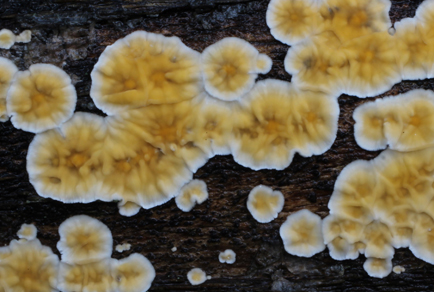Abstract
The aim of this work is to contribute to the knowledge of the diversity of stereoid fungi growing in the Patagonian Andes. In a recent survey we have found a species of Stereodiscus growing on Nothofagus antarctica in Southern Argentina, closely related to Stereodiscus trivialis but with distinct smaller basidiospores and characteristically encrusted pseudocystidia. The new species is described based on morphological features and phylogenetic ITS and 28S nuc-LSU data. In addition, a key to the known species of Stereodiscus is provided.
References
- Altschul, S.F., Gish, W., Miller, W., Myers, E.W. & Lipman, D.J. (1990) Basic local alignment search tool. Journal of Molecular Biology 215: 403–410. https://doi.org/10.1016/S0022-2836(05)80360-2
- Bresadola, G. (1920) Selecta Mycologica. Annales Mycologici 18 (1–3): 26–70.
- Chernomor, O., von Haeseler, A. & Minh, B.Q. (2016) Terrace aware data structure for Phylogenomic inference from Supermatrices. Systematic Biology 65 (6): 997–1008. https://doi.org/10.1093/sysbio/syw037
- Cohn, F. (1988) Kryptogamen-Flora von Schlesien. J.U. Kern’s Verlag, Breslan, 283 pp.
- Cunningham, G.H. (1956) Thelephoraceae of New Zealand. Part IX. The genus Stereum. Part X. The genera Cytidia and Aleurocystis. Part XI. The genus Aleurodiscus. Transactions and Proceedings of the Royal Society of New Zealand 84 (2): 201–268.
- Dai, L.D. & He, S.H. (2016) New species and new records of Aleurodiscus s.l. (Basidiomycota) in China. Mycological Progress 15: 717–730. https://doi.org/10.1007/s11557-016-1202-z
- Gorjón, S.P., Bobadilla-Peñaló, E.M. & Bobo-Pinilla, J. (2020) Phylogeny of Podofomes trogii reveals its relationships with Datronia in the Polyporaceae (Basidiomycota). Sydowia 73: 13–19. https://doi.org/10.12905/0380.sydowia72-2020-0013
- Gorjón, S.P., Greslebin, A.G. & Rajchenberg, M. (2013) The genus Aleurodiscus s.l. (Stereaceae, Russulales) in the Patagonian Andes. Mycological Progress 12: 91–108. https://doi.org/ 10.1007/s11557-012-0820-3
- Gorjón, S.P. & Hallenberg, N. (2013) Some new species and a first checklist of corticioid fungi (Basidiomycota) from Chile. Mycological Progress 12: 185–192. https://doi.org/10.1007/s11557-012-0824-z
- Greslebin, A.G. (2002) Flora criptogámica de Tierra del Fuego. Tomo XI. Fasc. 4. Fungi. Orden Aphyllophorales. Familia Corticiaceae sensu lato. Orden Tulasnellales. FECIC. Buenos Aires, 212 pp.
- Hall, T.A. (1999) BioEdit: a user-friendly biological sequence alignment editor and analysis program for Windows 95/ 98/NT. Nucleic Acids Symposium Series 41: 95–98.
- Hoang, D.T., Chernomor, O., von Haeseler, A., Minh, B.Q. & Vinh, L.S. (2018) UFBoot2: Improving the Ultrafast Bootstrap Approximation. Molecular Biology and Evolution 35 (2): 518–522. https://doi.org/10.1093/molbev/msx281
- Kalyaanamoorthy, S., Minh, B.Q., Wong, T.K.F., von Haeseler, A. & Jermiin, L.S. (2017) ModelFinder: fast model selection for accurate phylogenetic estimates. Nature Methods 14: 587. https://doi.org/10.1038/nmeth.4285
- Lemke, P.A. (1964) The genus Aleurodiscus (sensu stricto) in North America. Canadian Journal of Botany 42 (2): 213–282. https://doi.org/10.1139/b64-021
- Nguyen, L.T., Schmidt, H.A., von Haeseler, A. & Minh, B.Q. (2015) IQ-TREE: A fast and effective stochastic algorithm for estimating maximum-likelihood phylogenies. Molecular Biology and Evolution 32 (1): 268–274. https://doi.org/10.1093/molbev/msu300
- Oberwinkler, F. (1966) Primitive Basidiomyceten. Revision einiger Formenkreise von Basidienpilzen mit plastischer Basidie. Sydowia 19 (1–3): 1–72.
- Parmasto, E. (1967) Corticiaceae U.R.S.S. IV. Descriptiones taxorum novarum. Combinationes novae. Eesti NSV Teaduste Akadeemia Toimetised 16: 377–394.
- Phookamsak, R., Hyde, K.D., Jeewon, R., Bhat, D.J., Jones, E.B.G., Maharachchikumbura, S.S.N., Raspé, O., Karunarathna, A., Wanasinghe, D.N., Hongsanan, S., Doilom, M., Tennakoon, D.S., Machado, A..R, Firmino, A.L., Ghosh, A., Karunarathna, A., Mešić, A., Dutta, A.K., Thongbai, B., Devadatha, B., Norphanphoun, C., Senwanna, C., Wei, D., Pem, D., Ackah, F.K., Wang, G.N., Jiang, H.B., Madrid, H., Lee, H.B., Goonasekara, I.D., Manawasinghe, I.S., Kušan, I., Cano, J., Gené, J., Li, J., Das, K., Acharya, K., Raj, K.N.A., Latha, K.P.D., Chethana, K.W.T., He, M.Q., Dueñas, M., Jadan, M., Martín, M.P., Samarakoon, M.C., Dayarathne, M.C., Raza, M., Park, M.S., Telleria, M.T., Chaiwan, N., Matočec, N., de Silva, N.I., Pereira, O.L., Singh, P.N., Manimohan, P., Uniyal, P., Shang, Q.J., Bhatt, R.P., Perera, R.H., Alvarenga, R.L.M., Nogal-Prata, S., Singh, S.K., Vadthanarat, S., Oh, S.Y., Huang, S.K., Rana, S., Konta, S., Paloi, S., Jayasiri, S.C., Jeon. S.J., Mehmood, T., Gibertoni, T.B., Nguyen, T.T.T., Singh, U., Thiyagaraja, V., Sarma, V.V., Dong, W., Yu, X.D., Lu, Y.Z., Lim, Y.W., Chen, Y., Tkalčec, Z., Zhang, Z.F., Luo, Z.L., Daranagama, D.A., Thambugala, K.M., Tibpromma, S., Camporesi, E., Bulgakov, T.S., Dissanayake, A.J., Senanayake, I.C., Dai, D.Q., Tang, L.Z., Khan, S., Zhang, H., Promputtha, I., Cai, L., Chomnunti, P., Zhao, R.L., Lumyong, S., Boonmee, S., Wen, T.C., Mortimer, P.E. & Xu, J. (2019) Fungal diversity notes 929–1035: taxonomic and phylogenetic contributions on genera and species of fungal taxa. Fungal Diversity 95 (1): 1–273. https://doi.org/10.1007/s13225-019-00421-w
- Posada, D. (2008) jModelTest: Phylogenetic model averaging. Molecular Biology and Evolution 25 (7): 1253–1256. https://doi.org/10.1093/molbev/msn083
- Rajchenberg, M., Pildain, M.B., de Errasti, A., Riquelme, C., Becerra, J., Torres-Díaz, C. & Cabrera-Pardo, J.R. (2021) Species and genera in Aleurodiscus sensu lato as viewed from the Southern Hemisphere. Mycologia: 1940671. https://doi.org/10.1080/00275514.2021.1940671
- Reid, D.A. (1955) New or interesting records of Australasian Basidiomycetes. Kew Bulletin 10 (4): 631–648. https://doi.org/10.2307/4113780
- Ronquist, F., Teslenko, M., van der Mark, P., Ayres, L., Darling, A., Höhna, S., Larget, B., Liu, L., Suchard, M.A. & Huelsenbeck, J.P. (2012) MrBayes 3.2: efficient Bayesian phylogenetic inference and model choice across a large model space. Systematic Biology 61: 539–542. https://doi.org/10.1093/sysbio/sys029
- Spegazzini, C. (1888) Fungi Fuegiani. Boletín de la Academia Nacional de Ciencias en Córdoba 11 (2): 135–311.
- Tamura, K., Stecher, G. & Sudhir, K. (2021) MEGA11: Molecular Evolutionary Genetics Analysis version 11. Molecular Biology and Evolution 38: 3022–3027. https://doi.org/10.1093/molbev/msab120
- Vilgalys, R. & Hester, M. (1990) Rapid genetic identification and mapping of enzymatically amplified ribosomal DNA from several Cryptococcus species. Journal of Bacteriology 172: 4238–4246. https://doi.org/10.1128/jb.172.8.4238-4246.1990
- White, T.J., Bruns, T., Lee, S. & Taylor, J. (1990) Amplification and direct sequencing of fungal ribosomal RNA genes for phylogenetics. In: Innis, M.A., Gelfand, D.H., Sninsky, J.J. & White, T.J. (Eds.) PCR protocols. Academic Press, U.S.A., pp. 315–322. https://doi.org/10.1016/B978-0-12-372180-8.50042-1


